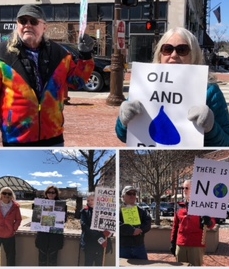In Our Own Back Yard
Tuesday, April 12, a group of us here in Wausau, known to most as Women for Women, hosted Esteban Chiriboga, in our series “In Your Own Back Yard.” Recently, we have found ourselves deep in environmental issues, namely water. Here is a little recap of this month’s presentation.
Water is Life.
Our topic this month was Enbridge Line 5. To give you a little background, the original pipeline was constructed in 1953. It extends 645 miles between Superior Wi and Sarnia, Ontario. Line 5 has 287 stream crossings in Ceded Territories. It leaves 82% of inland lakes at risk, 52% of river miles at risk and 70% of wetland acres at risk. Lake Superior and Lake Michigan are at risk in four separate locations. Line 5 runs under the Straits of Mackinaw. There have been thirty incidents resulting in oil spills, three of these were over one thousand barrels. Interestingly enough, most spills are found by the public. At the same time Pipeline right of way, in combination with the felony trespass law, deprives tribes and the public of any access to what is rightfully public land! Yes, you read that correctly! Often surface owners have no knowledge of the impacts, or the risks associated with crude oil pipelines. Furthermore, once the pipelines are installed, what flows through them can be changed! This is up to the company, no public notice needed.
Wisconsin has stepped up to the plate when it comes to Tribal involvement yet has a long way to go. Wisconsin tribes learned plenty from the fact there was little to no Tribal involvement in the impact assessments or the permitting process prior to the Minnesota Line 3 project. Enbridge caused ecological devastation in its construction of the new Line 3 through Minnesota. Its biggest known breach of an aquifer in January 2021 causing 100,000 gallons of water to gush out per day, for nearly a year. It was caused by Enbridge digging deeper than their permit allowed. There were also numerous frac outs during HDD (horizontal directional drilling). Did you know that the fluid used for drilling is often a source of PFAS? Enbridge plans to use the same technology in Wisconsin. The impacts of a comparable situation on the resources of Wisconsin should be included in the draft EIS.
The bottom line is the Environmental Impact Statement (EIS) needs to be updated to acknowledge the severity of the impacts of the pipeline on the water, wetlands, and climate of Wisconsin, as well as data collection to ensure compliance with Tribal, State and Federal law.
Meanwhile for more information on this month’s presentation: esteban@glifwc.org www.glifwc.org
In Your Own Back Yard is presented the second Tuesday of each month. Going forward, we will have zoom links available for you to join us. Please watch here at Middle Wisconsin News for more on our series. At the time of this printing, the May topic will be Mining, with emphasis on the mining east of Wausau.

